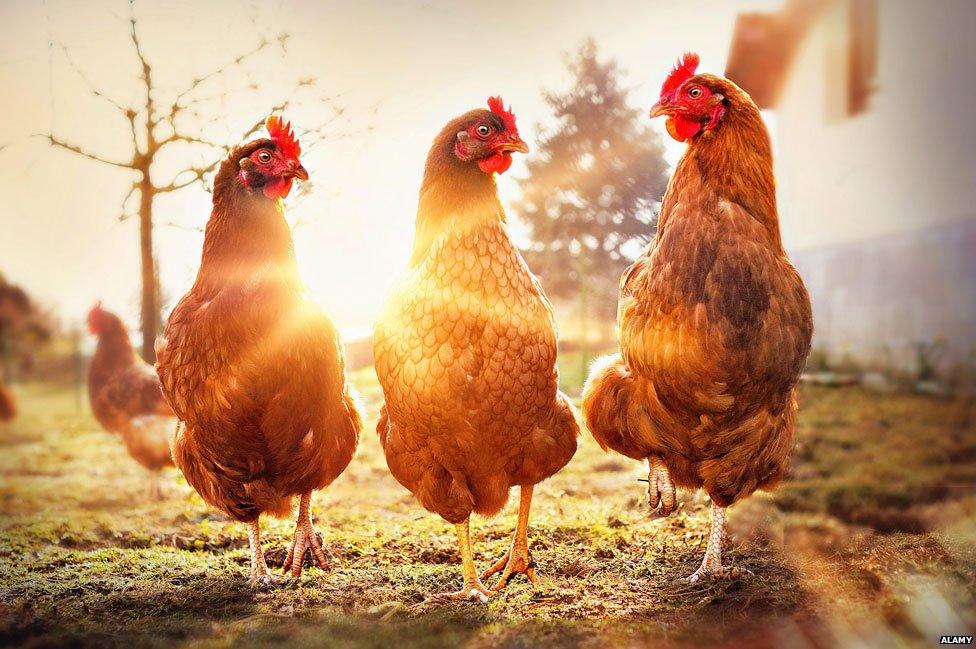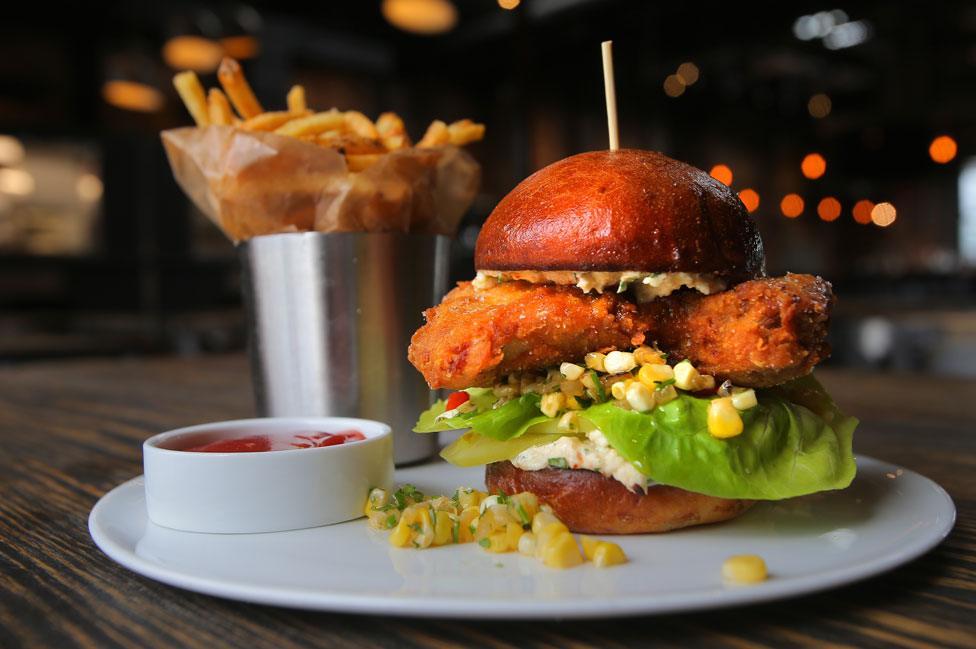Would you eat slaughter-free meat?
- Published
These chicken nuggets were grown in a lab from cells taken from a living animal
There's a looming crisis over the world's growing appetite for meat. Could a chicken running around a farmyard in San Francisco hold the key to a solution?
In 1931, Winston Churchill predicted that the human race would one day "escape the absurdity of growing a whole chicken in order to eat the breast or wing, by growing these parts separately under a suitable medium".
Eighty-seven years later, that day has come as we discovered at Just, a food company in San Francisco where we tasted chicken nuggets grown from the cells of a chicken feather.
The chicken - which tasted like chicken - was still alive, reportedly roaming on a farm not far from the laboratory.
This meat is not to be confused with the vegetarian plant-based burgers and other meat-substitute products which are gaining popularity in supermarkets.
No, this is actual meat grown from animal cells and variously described as cultured, synthetic, in-vitro, lab-grown or even "clean" meat.
t took about two days to grow our chicken nugget in a small bioreactor, using a protein to encourage the cells to multiply, some type of scaffold to give structure to the product and a culture, or growth, medium to feed the meat as it develops.
Those two days in the bioreactor came after years of work identifying the best cell lines, cell isolation and cell bank development, using cells from feathers or harmless biopsies on live animals.

Billions of animals are slaughtered annually for meat
Our chicken nugget was still in the prototype phase. Other prototypes can take days or weeks to grow. Just and other companies will need to speed up the process to mass produce the cellular meat.
The result is not yet commercially available anywhere on earth but Just's chief executive Josh Tetrick says it will be on the menu in a handful of restaurants by the end of this year.
"We make things like eggs or ice cream or butter out of plants and we make meat just out of meat. You just don't need to kill the animal," Tetrick says.
We were given a rare taste and the results were impressive. The skin was crisp and the meat flavoursome although its internal texture was slightly softer than you would expect from a nugget at, say, McDonalds or KFC.
Tetrick and other entrepreneurs working on cellular meat say they want to stop the slaughter of animals and protect the environment from the degradation of industrial factory farming.
They say they are solving the problem of how to feed a crowded earth without destroying the planet, pointing out that their meat is not genetically-modified and does not require antibiotics to grow.
The United Nations says raising animals for food is one of the major causes of global warming and air and water pollution. Even as the conventional livestock industry strives to become more efficient and environmentally friendly, many doubt it will be able to keep up with the rising global appetite for protein.
We slaughter 70 billion animals each year to feed seven billion people, says Dr Uma Valeti, a cardiologist who founded California-based Memphis Meats, a leading cell-based meat company.
He says the global demand for meat is doubling as more people rise out of poverty and that humanity won't be able to raise enough cattle and chicken to sate the appetite of nine billion people by 2050.
"So we could just literally grow any meat, poultry or seafood directly from those animal cells," Dr Valeti says. "I think that is probably much bigger than sliced bread."
Many Americans say they are eating less meat but US Department of Agriculture (USDA) figures suggest the average consumer will still consume more than 222lbs (100kg) of red meat and poultry this year - about 20lb more than they ate in the 1970s.

The demand for meat is growing worldwide
The pioneer of cellular agriculture is Dutch scientist Mark Post. His first lab-grown hamburger, grilled in 2013, cost $300,000 (£228,000).
No company has yet scaled-up production to serve a cell-based patty commercially but Post estimates that if he started mass producing his burgers, he could get the cost of making them down to about $10 each.
"That's of course still way too high," he said.
If Just does manage to produce enough chicken nuggets to sell this year, it is unlikely to be in an American restaurant as the US government is still deciding how to proceed.
Most food in the US is regulated by the Food and Drug Administration (FDA). But some - mostly conventionally raised meat - is regulated by the USDA. So if you're buying a frozen pizza in the US, the USDA handles the pepperoni version and the FDA handles the cheese.
"There are a number of countries in Asia and Europe that we're talking to," Tetrick says. "There's a lack of clarity" about regulations in the US while the USDA and FDA hold public hearings, he explains.
"I think countries want to take the lead in this. Whether it's food scarcity, whether it's sustainability issues or they just want to build an entirely new economy, they want to take the lead in doing this," Tetrick said.
The eventual aim is to move cellular meat out of the laboratory and into large manufacturing plants.
There are now dozens of companies working in the field and they're attracting venture capitalist investment from across Silicon Valley and beyond. Billionaires Bill Gates and Richard Branson are among those who have ploughed money into the technology.
The product also has a more surprising benefactor in Tyson Foods, which has invested an undisclosed amount in Memphis Meats.
Tyson is the biggest meat processor in the US, processing around 424,000 pigs, 130,000 cows and 35 million chickens every week. So why is it investing in cellular meat?
The firm decided "to shift from being a meat company to a protein company," said Tom Mastrobuoni, chief financial officer for Tyson's venture capital arm, Tyson Ventures.
"We've made the conscious decision that we're going to be the biggest protein company," he added.
The cutting edge technology of Silicon Valley may be synonymous with the freewheeling, entrepreneurial spirit of the United States but this is still a country where tradition runs deep.
The Cattlemen's Association has a powerful lobby and there's arguably no symbol more revered or romanticised in the nation's history than the cowboy.
And so the ranchers of the mid-west are stepping into the debate about how this new product will be marketed - as clean meat, cellular meat, slaughter-free meat, ethical protein, or just meat?
On their ranch in the Ozarks, a mountainous region extending from Missouri into Arkansas, Kalena and Billy Bruce are feeding their herd of black Angus cattle, helped by their four-year-old daughter Willa.

Kalena and Billy Bruce, with Willa
"I think it needs to be labelled accordingly - a lab-produced protein," says Billy Bruce. "When I think of meat I think of what's standing behind us, a live breathing animal," he adds.
The state of Missouri agrees. At the urging of farmers, the legislature has decreed that meat labels may only be applied to the product of livestock. It is a hint of the disruption which traditional agriculture feels could be on the way.
"From a transparency standpoint for consumers, so that they know what they're purchasing and what they're feeding their families, we think that it needs to be called something different," says Kalena Bruce.
Lia Biondo, the director of policy and outreach with the US Cattlemen's association, based in Washington, DC, says she expects the Missouri law could be replicated in other states.
"We will let those companies decide what to call their products just as long as they don't call it beef or meat," says Biondo.
But in any case, will anyone actually eat it, especially here in cattle country?
Diners at Lamberts, a traditional Midwest restaurant in Ozark, Missouri, are going to take some convincing.
"Meat oughta be growed on a farm, out in the fields," declares Jerry Kimrey, a construction worker from Lebanon, Missouri.
Teacher Ashley Pospisil, also from Lebanon, says she would prefer not to eat cell-based meat.
"I like to know where it came from and that it's natural and not processed from a lab," she says.
Linda Hilburn, who is tucking into a (cow) steak before heading home to Guthrie, Oklahoma agrees.
"I kind of like it having four feet in the beginning," she says.
"There's just something about man's creation that scares me. We've created havoc here. I kind of like the idea of God's creation."
While Ms Hilburn is far from alone in feeling squeamish about the idea of "Frankenstein food" as critics have labelled it, Josh Tetrick insists that cell-based meat is entirely free from the many animal diseases which plague traditional meat production.
And he is betting on human experience favouring progress.
"At the end of the day whether you're talking about a move from picking ice to refrigerator or from slaughtering a whale to refining oil into kerosene and moving from kerosene to a light bulb... even though people called the light bulb the Devil's current... humanity managed to embrace something new.
"It always happens and if I had to bet it'll happen for this too."